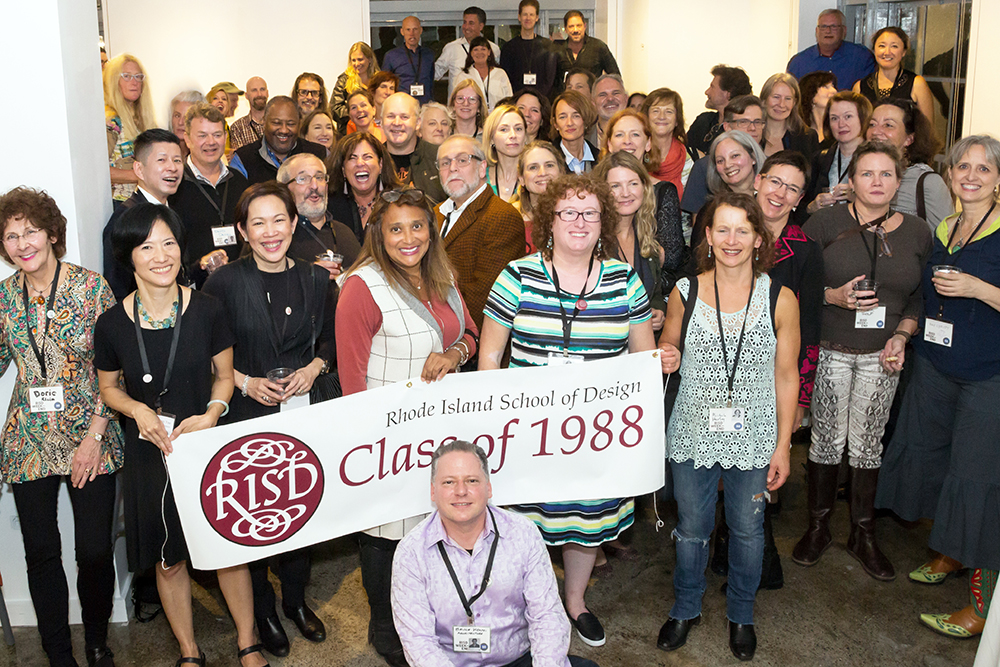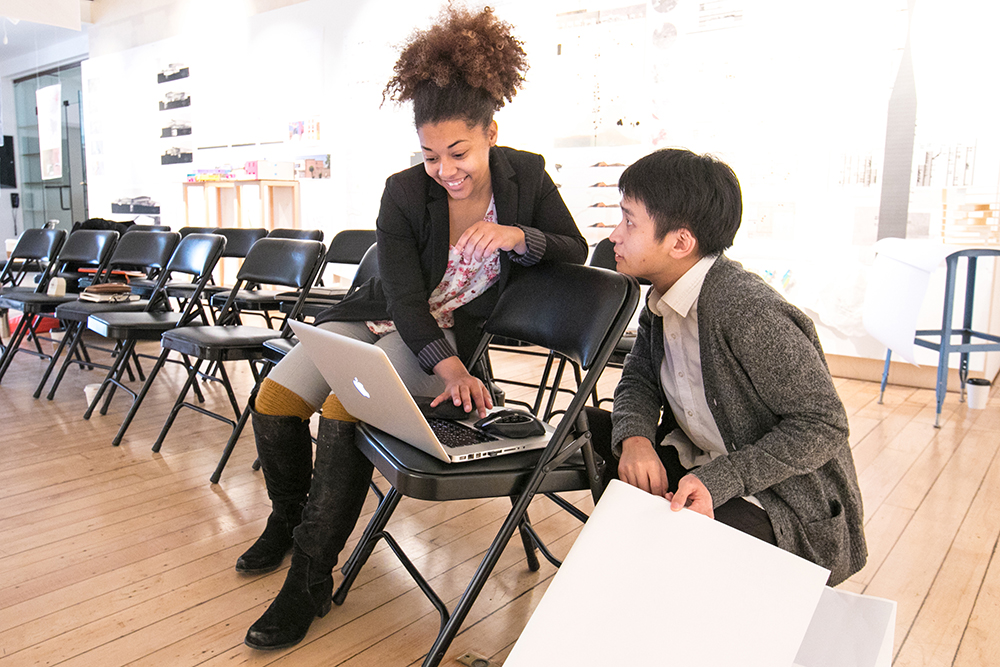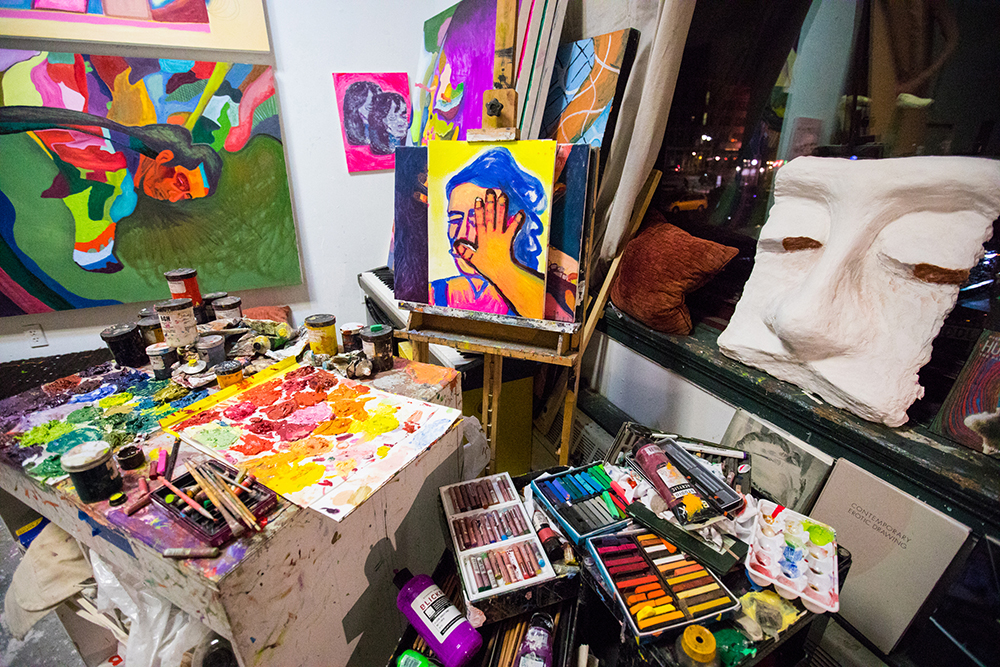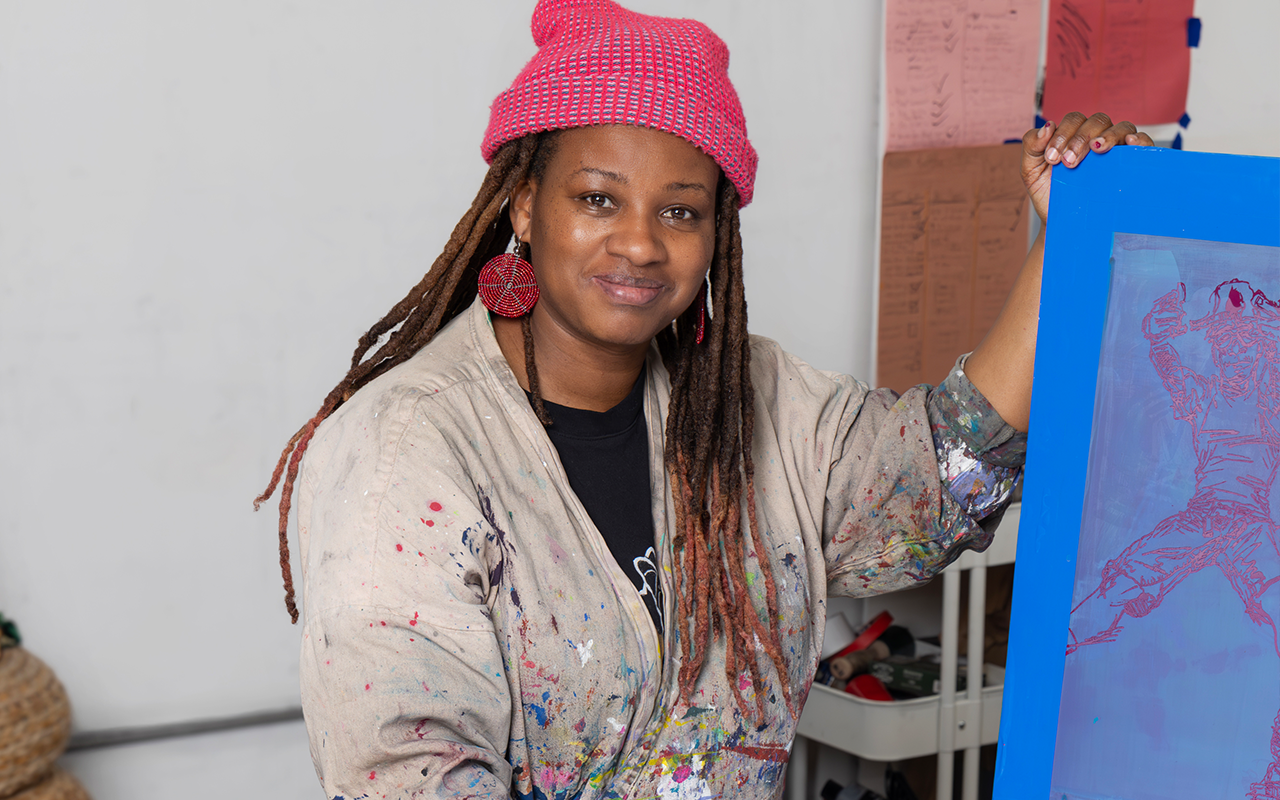
In the Studio: Jazzmen Lee-Johnson 08 FAV
My studio is in Atlantic Mills, at the Warp Collective. Eight artists work here. We each have our own little bay, with shared space for printmaking, weaving, spreading things out. There’s skill sharing, too. Jordan Seaberry 14 PT [Asst. Professor EFS] is a painter, Eric Sung is a photographer, Nat Brennan 20 IL, Lu Heintz 01 SC, and Eliza Squibb 13 TX do textiles and sculpture, Becci Davis is a multimedia artist and Cybele Collins 02 IL is a biogeochemical scientist painter! So we’re always like, How do you do this? Can you help me with that? Can I borrow some tape? This is one of the last mill spaces in Providence occupied mostly by artists, nonprofits, entrepreneurs, and a flea market. It’s a really important space for the community, and it’s currently under threat of sale to a developer. So many artists have come through over the years. Kara Walker MFA 94 PR/PT used to have a studio across the hall, so I feel like there's good juju here, good vibes. It’s generational energy.
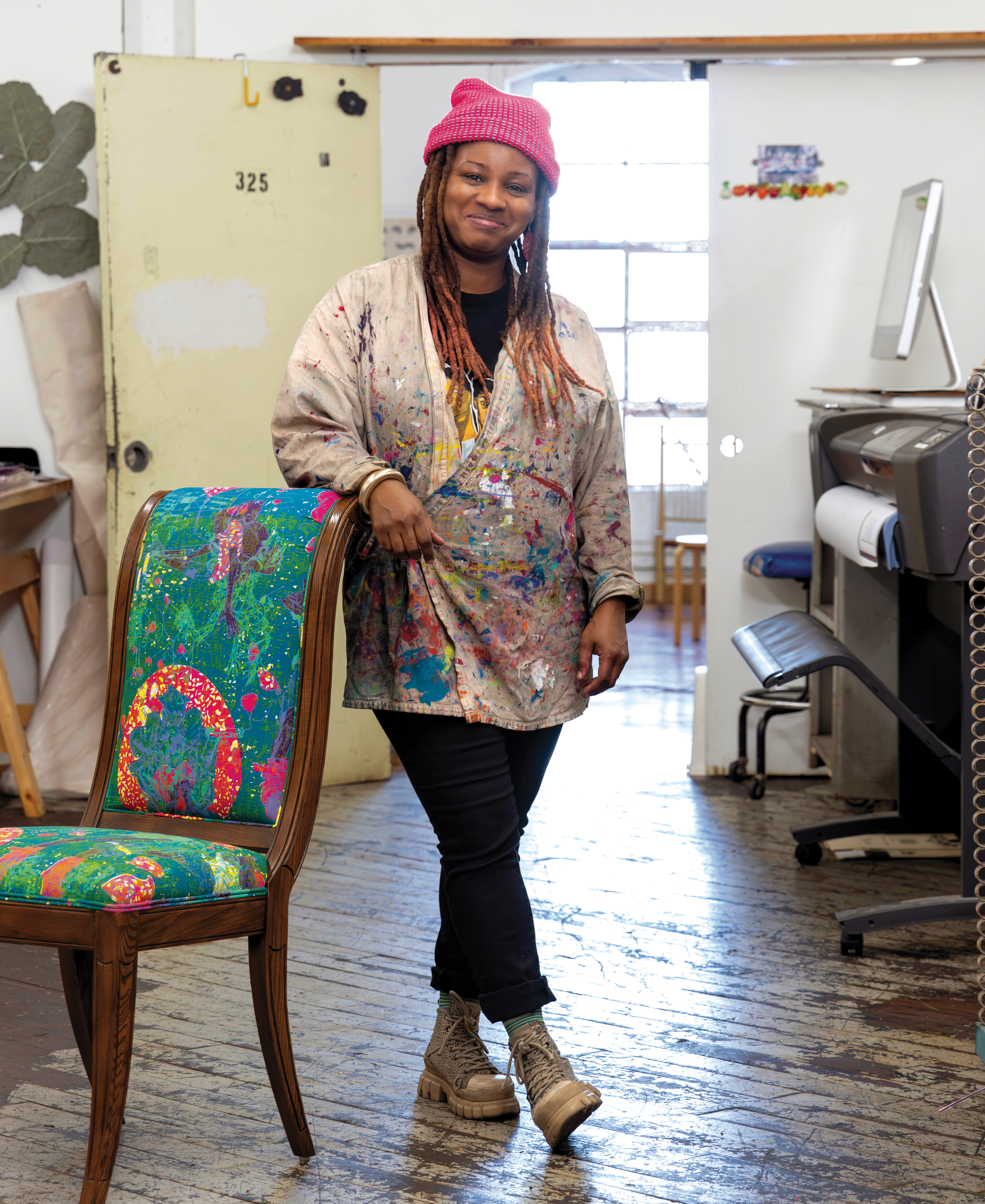
I have a show coming up at The Wurks called Retroactive Mix [the show ran from December 14, 2024–January 10, 2025]. It will include work from the past ten years—some in progress, some current and complete, some from over a decade ago. I lived between New York and South Africa for many years, doing music and performance, and I recently found a track my friend Kwelagobe and I recorded when we were 23. I played it for him, and he said, “It’s like we recorded this last week!” Back in the day, we didn’t have ways to send large files across the Atlantic Ocean other than waiting for someone to come to town with a hard drive or CDs. So we have all this material, which I’ll include in Retroactive Mix, as well as a lifelong project with my band, Folk Told Me—an audio-visual graphic novel called Grandma’s Lament/Sello sa Nkoko.
I’ll also show things people haven’t seen in person, like my original illustrations for the young readers’ version of Zora Neale Hurston’s Barracoon. People have seen the art in the small book, but they haven’t seen the original, large charcoal drawings. I’ve loved charcoal drawing since high school. For this book, I smeared and rubbed layers of charcoal on drawing paper, then used an eraser to pull light and create shape and depth, finishing finer details with a white charcoal pencil. Folks have been very receptive to the book and the imagery. I’ve heard adults really like it too. And it was just nominated for an NAACP Image Award. I’m also showing a slab of granite we used to test the laser engraving for my illustrations on a memorial to the victims of the 1873 Colfax Massacre in Louisiana.
And then there’s Contraband, a series of three prints that have never been seen together until now. Contraband started in 2019, when I was doing a research fellowship at the American Antiquarian Society in Worcester. Working in their archives, I asked about objects related to the business of slavery. They had ledgers and early currency and also something called Civil War envelopes. I kept seeing these recurring illustrations of Black people running or celebrating on these envelopes, and they would read something like, “We’ve made it to Fort Monroe. We’re contraband now.” I was like, Well, what’s that about? I learned that if you were enslaved and made it to Union territory during the Civil War, you were in this limbo space where you weren’t quite free because the war was in process. You were considered “contraband.” There were even contraband camps in Virginia, where Black people either just camped out or prepared to fight for the Union side.
So that really struck me. A body, a Black body, as contraband. And then something else came to me. Reading rooms and libraries have a lot of rules, rightfully so—like you can’t have drinks in here, or bring in certain technology. So when I would take breaks from the reading room, I would scroll on Instagram, and a lot of my family would pop up of course, especially my cousins. And there was this weird connection between what I was seeing in the archive and in my cousins’ posts. They were posing with their own forms of contraband—illegal goods, drugs, or weapons—in the “envelope” of my phone.
Noticing this connection alongside what I saw in the ledgers—Black bodies being traded for clothes, alcohol, and such—I realized that the relationship between Black bodies and contraband, whether spoken or unspoken, still exists. Over history, Black folks have had to create their own economies. If you experience enslavement and then all of a sudden you’re out of it, how can you make money without going back into the same systems and structures that enslaved you? It’s similar to how Black people not being able to gather in groups in public carried over into stop and frisk. All these linear or nonlinear connections persist between the past and the present.
So, in the prints, I responded to the ephemera I found in the archives. The prints are each in the format of a stamp, currency, and a legal document—all scaled up. I started by drawing portraits from my cousins’ Instagram posts, with their permission. The titles are all pulled from their photo captions. One is called Trained 2 Go. The image was of boys throwing up gun signs with their hands—like they’re trained and ready to go, like an army—and that’s also the name of a gang in Baltimore. If you look closely, you’ll also see artifacts from fortresses in Benin and Ghana that were looted by the British and the motif of Black bodies lined up on a slave ship. The prints are very colorful because these stories are bleak, and I wanted the color to be an invitation. You’ll see this bright thing and then look more closely. My work is very layered and loaded, and you don't need to have a context to have a response or reaction. But as you look closer you might wonder, What does this mean?
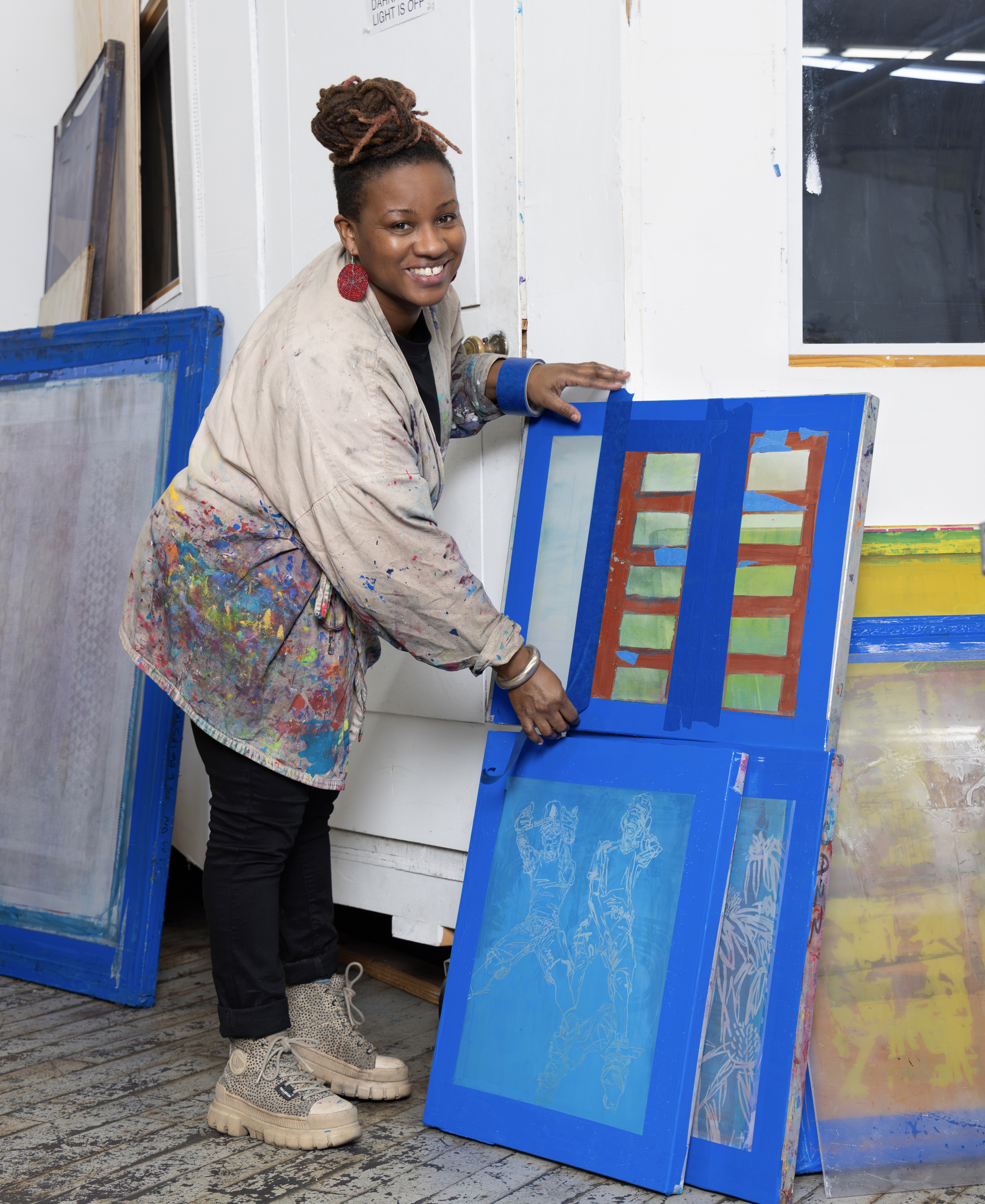
You can see remnants of animation techniques in the tracing and layering of the figures. I studied in FAV at RISD. The other “remnant” is from grad school in Public Humanities at Brown. I took courses in history, Africana studies, ethnomusicology, et cetera. I probably read more in one semester at Brown than I had in the five years before. I was not an academic, and it was hard and alienating, and I had to figure out how to process it and translate it into my own visual language. I mean, reading Homi Bhabha and Audre Lorde and Foucault and all, that helps me contextualize and have conversations about my work, but a lot of the concrete processing is still visual for me. Instead of reading a secondary source about the business of slavery, I want to see the pictures. Images are just so telling. They tell every story across time.
Contraband has become the introduction to a broader body of work I’m calling Go ‘head and fix you a plate. I have lost family members to gun violence. So as I’ve been exploring the gun as contraband, I’ve also been thinking about loss and grief and who’s left behind. I often think of the matriarchs in the family—my great grandmother, my mom, my aunts—and how their homes have been a place to gather, to mourn, to organize, to say, alright, we have got to get this cousin out of this neighborhood. Can he come stay with you? How can we get him in the schools here? Or let’s get organized. Jazz is going to college. How are we going to pay for her plane ticket? You go over to Cindy’s house and she says, “Go ’head and fix you a plate.” You know, you’re home, you’re welcome. You can chill or talk or not talk or be silly or grieve, but you gotta eat.
So this work is expanding. It keeps growing. Right now I’m reupholstering furniture. I have these dining room chairs like the ones we would sit on during a funeral repast at my great grandmother’s house. Eventually, I want to create the entire domestic space, the living room, the dining room, the kitchen. I’m screen printing multilayered repeat textiles I designed in response to the toile de Jouy style. One of the early toiles pictured the invention of hot air balloons in France, and balloon mania, and the successes and failures of taking flight. I’ve transformed this balloon motif to reference the street memorials erected for family who have passed due to gun violence or terminal illnesses, with balloons and candles and such placed in public space.
The themes in this work explore how the technologies of the past—colonialism, enslavement, apartheid—still guide our realities in the present, just in different cadences.
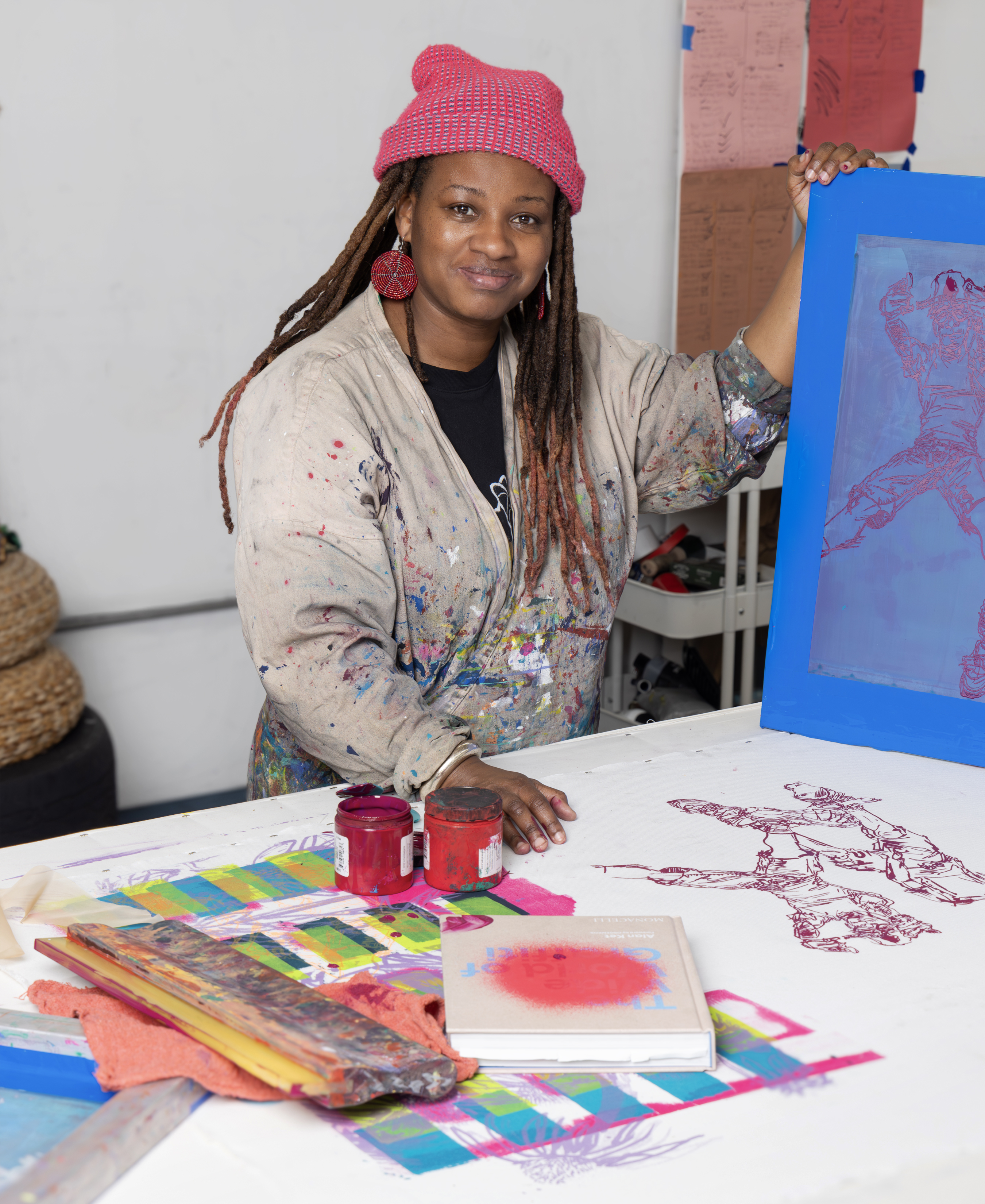
This narrative is edited and condensed from a conversation with Jen Liese, Director of RISD’s Center for Arts & Language, on December 7, 2024.
Image credit: Jazzmen Lee Johnson Photographs © Adam Mastoon

